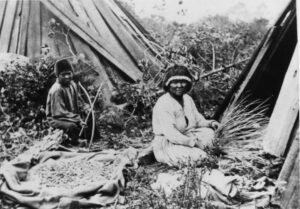
Pomos lived along the Mendocino Coast for thousands of years prior to European settlement in 1850. Pomo simply means “the people.” In 1855, the federal government established the Mendocino Indian Reservation on 25,000 acres between the Noyo and Ten Mile Rivers, with its military headquarters located in what is now the business center of the town of Fort Bragg, ten miles north of Mendocino. It is reported that by 1857, thousands of Native Americans (not all Pomo) had been rounded up from as far away as Eureka and Chico and confined on this reservation for nine years before it was discontinued in 1866. Reservation lands were then sold off to European settlers and the Coastal Pomos were relocated elsewhere, many went inland to the Round Valley Reservation
Our Native American exhibit offers a historical overview of Mendocino’s earliest residents, as well as an array of photo prints and artifacts depicting their way of life. On loan from the California Indian Museum are six examples of decorative gift and utilitarian baskets belonging to the Daisy Kelley MacCallum Collection. And from the Dorothy Byrnes Leonard Collection are examples of decorative gift and utilitarian baskets, a woven infant carrier, and a duplicate toy cradle.